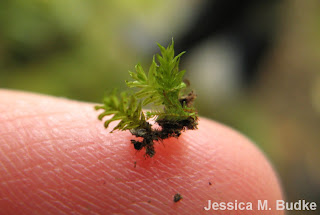We spent an afternoon digging through moss mats looking for fern gametophytes. The main body that you would typically call a fern (the large, dissected, frond portion) is a sporophyte. Equivalent to this portion of the moss. Ferns also have gametophytes, however they are not nearly as large as the leafy green moss gametophytes. Fern gametophytes are typically less than a centimeter in size and one cell layer thick. We were particularly interested in finding gametophytes of epiphytic ferns. An epiphyte is a plant that lives on another plant. The plant that it lives on is called a phorophyte (phoro- meaning carrying or bearing). The epiphyte may are may not be parasitic on the phorophyte, but usually when people are talking about epiphytes in general they are not. The gametophytes of the epiphytic ferns are typically ribbon shaped and nestled within the fern mats that grow on tropical trees.We collected moss mats off of trees and then dug through them in the lab in search of fern gametophytes. Here are some photos of the process and what I found with some of the photos below the fold.Above is a piece of the moss mat that I was digging through. You can see my finger for scale.
This is one of the fern gametophytes that we found in the moss mat. I personally found one, but did not get a picture of it before passing it off to share with others. This is a ribbon-shaped gametophyte that is from a fern in the Hymenophyllaceae (filmy fern family).
While searching through the moss mat I came across this tiny snail shell. It is only a millimeter long, hence the fuzzy photo. It was so tiny and very cute.
The moral of the story is that there are tons of plants and animals besides moss growing in a moss mat. They are their own mini ecosystem. This idea is not limited to moss mats of the tropics. I have explored moss mats in Connecticut and found many interesting creatures.





























